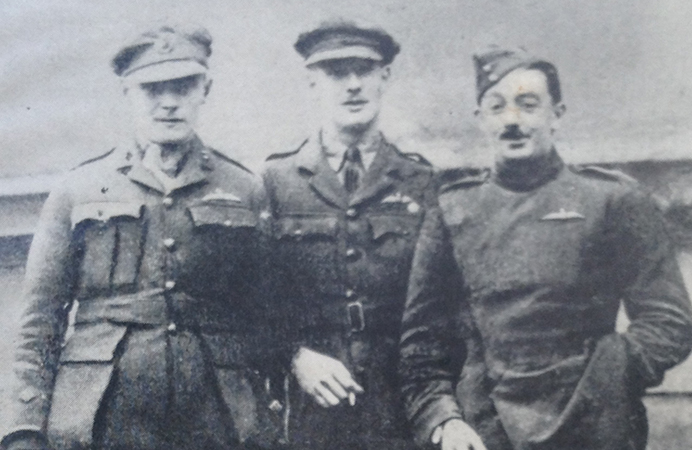To the Germans, he was ‘one of the most dangerous characters in the country’; to fellow prisoners he was an inspiration and a hero. We have the handwritten notes of Harold Medlicott’s 10 escapes from prison camps during the First World War.
Harold was from Ealing. We ran a story on his incredible wartime escapes a few years ago when his name (along with that of his brother Sidney) was belatedly added to Ealing War Memorial.
More recently, we wrote of how his wooden trunk was uncovered in a garden shed, miles away from London – and how we helped enable its safe return to his family.
Thanks to his family members, Brian and Charles Medlicott, we now have copies of what are believed to be Harold’s handwritten notes, in which he detailed each of his escapes – said by others to have been a record number of attempts. They make for remarkable reading.

Harold was an ‘ace’ pilot in the Royal Flying Corps (the forerunners of the RAF) and had been mentioned in dispatches. The Times newspaper described him as a ‘daring and skilful pilot, and he was successful in bringing down a number of enemy machines’.
He ended up as a prisoner of war (POW) after his plane developed engine trouble during a snowstorm and caused an enforced landing behind enemy lines in November 1915.
The picture at the top of this article is of Harold (on the left) with two fellow prisoners at his first prison camp in Weilburg.
‘He glared back menacingly like a caged animal’
Almost 200,000 British military servicemen were captured by the Germans during the First World War and became POWs. Conditions in the prison camps varied and some POWs were paid for work or were allowed to put on entertainment; but there were also harsh regimes, tough daily routines and a lack of basic everyday necessities. Punishment for many involved forced labour or physical beatings. The POWs would cope by building organised networks of friendship, leadership and support, and arrange forms of resistance – including escape.
Harold was certainly one of the leading lights when it came to escape attempts. He would do it again and again, despite the low odds of success (said to be 600 to one) and constantly being recaptured and punished.
Historian Mike Lawson wrote in our original article: ‘Despite the alleged brutal beatings dished out to recaptured prisoners, these apparently only made Harold even more pugnacious and he is said to have glared back menacingly like a caged animal.

‘Although he was fearless, he was not a talkative man because secrecy was the key to escaping. Yet Harold’s arrival at any new camp would raise the morale of the prisoners. Correspondingly, the Germans would feel a loss of morale upon his arrival and it was often said that camp commandants would try to pull strings with the object of preventing Medlicott from being sent to their camp.’
Harold’s notes on his escapes
Using Harold’s notes, we looked at how his 10 escapes unfolded.
While being detained in Weilburg (pictured at the top of the page), he escaped for the first time on 13 April 1916 in the early hours of the morning. He crept into the room of a Belgian general and used a ‘drawbridge’ made of ‘form and curtains’ to exit out of the window. He was accompanied by a Captain Alex Stewart and the pair were then on the run for four days, heading south past Frankfurt and covering 120km in cold and wet conditions. They made it as far as a large town called Darmstadt, where they had hoped to jump on an aeroplane out of Germany. But a suspicious German officer stopped and questioned them and then raised an alarm and, while Medlicott and Stewart walked quickly away and continued to head south, the police grabbed them two hours later and returned them to the prisoner-of-war camp, where they ended up serving 63 days’ punishment. In his handwritten notes, Harold says lessons learned were: ‘Having once been spoken to en route, change direction at once’.
Having been shifted camp, to make it harder for them to escape from less familiar surroundings, Harold made another even more daring escape in June the same year – again with Captain Stewart. They were being held at Friedberg, not a long way from the previous camp. In broad daylight, in the middle of the afternoon, the pair grabbed a ladder in the exercise yard and managed to get over the wall and make a sprint for it. However, they only got two kilometres away, in about half an hour of ducking and diving for cover, before being given away by a local boy who spotted Harold from behind while they hid from a search party. Lesson learned was recorded as always keeping a ‘good look-out to the rear’ as well as to the front. They were handed 14 days’ punishment.
By August, Harold was in yet another different camp – this time, in Hann Münden. It was ripe for the third of his escapes. Early in the morning of 3 August, he and a second lieutenant called JS Poole made the most of a gap between sentries along the wire boundary fence and climbed over. In hot weather, the pair struck out in a north-easterly direction and eventually skirted around Berlin and found themselves in the rural town of Rosenbeck. On the way, they had to hide whenever spotting someone. And they got incredibly unlucky when one of their hiding places was, literally, stumbled upon by an off-duty soldier who was stalking deer and armed with a gun. Stunned, the pair did not run away, giving the officer a moment to challenge them and arouse his suspicion. He then took them to the authorities at gunpoint. They were taken back into custody and ended up being given 25 days’ punishment. Lesson learned was rather sardonically recorded as: “If you see men with gun clear out before challenged.”
So close…and then ‘Colditz’
Undeterred, just two weeks later and in the same Hann Münden camp, Harold teamed-up with a soldier by the surname Voelker (a lieutenant in the SLI – either Somerset Light Infantry or the Canadian Saskatoon Light Infantry). Not long after dawn, the duo dressed up as camp orderlies and carried some food to a pen of pigs. They were then able to use their disguises to exit the camp. This most comical of escapes so nearly worked brilliantly for Harold – but not for Voelker. They headed west for a way towards Paderborn and, for some reason, they became separated and Voelker was captured. Harold appears to have immediately struck due north, perhaps learning from previous attempts by making a distinct change of direction. In total, he managed to get 190 kilometres away from the camp, over the course of six days. But, in the town of Munster, misfortune hit Harold when he was spotted by a police detective while buying a change of clothes and some food in the marketplace – seemingly given away by his unkempt appearance. He was captured and taken back into custody and handed 42 days of punishment. His lessons learned were interesting, stating: “When forced to enter big town, shave growth and enter after sunset.”
Still being held at Hann Münden, Harold was reunited with his previous fellow escapee JS Poole and the pair hatched a plot for another escape, along with a third conspirator called Captain Oliphant. On 21 October, the trio managed to steal some kind of cutting tool to get through the wire of both boundary fences, in between sentry posts. They appear to have decided to take the same route as before, heading west towards Paderborn and then striking northwest. This time, they managed to get past Munster and travelled for seven days – eventually reaching Coesfeld, which was painfully close to the Dutch border, and freedom. However, they were spotted by a civilian shooting party of two men and, at gunpoint, were handed over to a German soldier. They managed to break free of the soldier and scattered. Harold, and then Oliphant, were retaken by a joint force of soldiers and civilians. But Poole managed to get away and cross the border. One out of three is not bad. Harold resolved to be more ruthless next time, writing: ‘If taken by civilian near frontier, bind and gag them and clear out’ – meaning he would risk his life to use force to subdue any prospective capturers in future.

He was sent to a new camp for trial and punishment. It was a Colditz-like establishment for serial offenders, at Ingoldstadt. Those who had made attempted escapes elsewhere would learn to behave here, it was thought.
However, in December, with Christmas approaching, Harold rustled up the support of a fellow inmate at this imposing new ‘home’ of Straflager Fort in Ingolstadt. Lieutenant SE Buckley was, like Harold, in the Royal Flying Corps. They resolved on 19 December to escape in ‘muck boxes’ being taken away from the fort. However, they did not get very far from the gates when they were tipped out and spotted by civilians, who raised the alarm. This failed attempt resulted in 14 further days’ punishment.
Ice, snow and gunshots
Although 1917 may have been a new year, it did not initially halt Harold’s resolution to break out of internment and head home. His escapes continued.
On 27 January, he was joined by another Royal Flying Corps comrade in the shape of Captain AJ Evans and they got away from the fort in Ingolstadt under the cover of darkness by cutting wire placed over the gap where a failed escape attempt had previously been made by French servicemen. The pair crossed the frozen moat around the fort by sliding carefully over the ice. Unfortunately, as dawn broke, they stood out like a sore thumb against the thick blanket of white snow that covered the landscape and Harold said it was ‘bad going’ as they struggled through the drifts. Patrols were soon in pursuit and they were fired upon. Eventually, exhausted, the pair took shelter behind a house and tried to hide but were spotted and taken back into custody. His lesson learned from this attempt was: “Never escape with snow on ground unless good start can be made.” He was moved camps once again.
There was then a 10-month period when Harold laid low. It is unclear whether his conditions made it more difficult to break free, but he was now being held in Clausthal. On 10 November he had decided to escape again – this time with the help of Captain JS Walter. At 2am, they cut wire next to the front gate and fled. The weather was very wet and cold but they managed to keep going for 19 hours and covered 32 kilometres and reach a railway station, where they bought tickets. But, with the train just five minutes away from arriving on the platform, German police arrived to arrest them – presumably having been tipped off by someone at the station. They were taken back and handed 22 days’ punishment. Harold resolved not to ‘go near a station which is likely to be on the look out.’
Harold decided to wait-out the worst of the weather and did not try another of his escapes again until 10 February 1918. He had been moved to yet another camp – but he appears to have just seen each new camp as a new challenge. With his buddy Captain Walter again, he bust out of Holzminden by cutting wire above iron railings and climbing out as fast as possible. He even recorded the time it took as 20 seconds. They were seen by a man who looked after the arrest cells in the basement of the building, but he did not have time to get out before the escapees had got outside. When 200 metres away, sentries from the camp opened fire on them and they were chased for two kilometres before being caught and dragged back – and handed 27 days’ punishment. No lessons were recorded as having been learned. Perhaps, Harold was growing more desperate?
‘Murdered in cold blood’
Harold and his erstwhile companion Walter were both moved to Bad Colberg. This is where Harold’s notes come to a premature end – because the final one of his escapes attempt proved fatal.

After serving a term of imprisonment, Medlicott and Walter were warned by the camp commandant that if they should achieve the impossible and get out of the camp they would never return alive. Undeterred, it was from here that Harold made his final escape, again with Walter.
On 18 May, they managed to escape through the toilet window of an arrest barrack – with Walter lowering himself to the ground by a rope he had made from his bed clothes, and Harold following close behind. The weather was hot and they managed to run for almost 24 hours, covering 24 kilometres. They were found and arrested by police at Romhild.
According to Mike Lawson: ‘They were brought back to a railway station near Bad Colberg. According to the Germans, they were shot while attempting to escape from the station, but the British were not convinced by this version of events. Two days later the dead bodies of Medlicott and Walter were returned to the camp.
‘A British soldier working as an orderly in the mortuary later testified that the two men’s bodies had received numerous bayonet wounds. A Court of Enquiry was set up at the camp, unknown to the Germans, and it concluded that Medlicott had been murdered in cold blood because he was a nuisance.’
Medlicott, then 25, and Walter were buried not far from the camp but were later re-buried side by side in the Commonwealth War Graves Commissions’ Niederzwehren Cemetery at Kassel.
‘Odds of six hundred to one’
There were numerous death notices in national newspapers at the time. All marvelled at Harold’s escapes and bravery.
The Daily Telegraph (on 13 June 1918) wrote: ‘It is said Lieutenant Medlicott held the record for attempted escapes… Captain Walter had twice before escaped from camps with Lieutenant Medlicott. Lieutenant Medlicott was one of the foremost among prisoners who consistently attempted to escape and was considered by the German authorities to be one of the most dangerous characters in the country. Neither of the two men knew what fear was.’
The day after, in the Evening Standard it was written: ‘The odds against an escaping prisoner getting clear of Germany are, I believe, about six hundred to one; in fact, only about a score (20) of officers have accomplished the feat…such men as Medlicott must be regarded as splendid examples of pluck and patriotism.’







